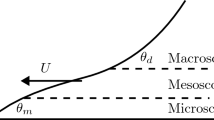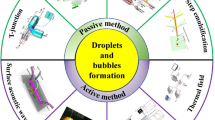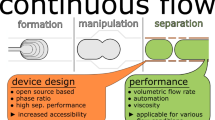Abstract
A volume of fluid (VOF) numerical study is presented in which new pi number-based criteria are discussed that identify and separate three different regimes for a droplet-on-demand (DOD) print-head system. A trailing filament coalesces into the main droplet while the filament breaks into one or multiple satellite droplet(s). The numerical simulation results are compared with published large-scale experimental results that used a 2 mm diameter inkjet nozzle head, roughly 50 times larger than the actual diameter of inkjet outlets. Liquid filament break-up behavior is predicted using a combination of two pi-numbers, including either Weber (We)-Ohnesorge (Oh) number couplets or Reynolds (Re)-Weber (We) number couplets that are dependent only on the ejected liquid properties and the velocity waveform at the print-head inlet. These new criteria have merit over the currently existing ones that require accurate measurements of actual droplets to determine filament physical features like length and diameter [1].
Similar content being viewed by others
References
S.D. Hoath, S. Jung and I. M. Hutchings, Physics of Fluids (1994-present), 25, 021701 (2013).
R. F. Burr, D.A. Tence, H.P. Le, R.L. Adams and J.C. Mutton, US Patents, 5,495, 270 (1996).
B. Jo, A. Lee, K. Ahn and S. Lee, Korean J. Chem. Eng., 26, 339 (2009).
A. A. Castrejón-Pita, J.R. Castrejón-Pita and G.D. Martin, Review of Scientific Instruments, 83, 115105 (2012).
C. Lee and S. Yi, Korean J. Chem. Eng., 21, 1153 (2004).
A.U. Chen and O. A. Basaran, Physics of Fluids (1994-present), 14, L1 (2002).
O. A. Basaran, AIChE J., 48, 1842 (2002).
D. Im, Korean J. Chem. Eng., 32, 1 (2015).
H. Dong, W.W. Carr and J. F. Morris, Physics of Fluids (1994-present), 18, 072102 (2006).
A. A. Castrejón-Pita, J.R. Castrejón-Pita and I.M. Hutchings, Physical Review Letters, 108, 074506 (2012).
J.R. Castrejón-Pita, N. F. Morrison, O. G. Harlen, G.D. Martin and I. M. Hutchings, Physical Review E, 83, 036306 (2011).
J. Fromm, IBM Corp., Yorktown Heights, NY (1981).
E. Kim and J. Baek, Physics of Fluids (1994-present), 24, 082103 (2012).
Q. Xu and O. A. Basaran, Physics of Fluids (1994-present), 19, 102111 (2007).
H. Wijshoff, Physics Reports, 491, 77 (2010).
F. Yang, S. Zhou, C. Zhang and G. Wang, Korean J. Chem. Eng., 30, 1843 (2013).
S. Poozesh, N. Akafuah and K. Saito. SAE Technical Paper, No. 2015-01-0737 (2015).
J.M. Delhaye, N. Coutris and L. Herran, ASME International Mechanical Engineering Congress and Exposition, Proceedings (IMECE), 8 C (2013).
R. Emori, K. Saito and K. Sekimoto, Tokyo, Japan: Gihodo. Second Print in (2008).
Author information
Authors and Affiliations
Corresponding author
Rights and permissions
About this article
Cite this article
Poozesh, S., Akafuah, N. & Saito, K. New criteria for filament breakup in droplet-on-demand inkjet printing using volume of fluid (VOF) method. Korean J. Chem. Eng. 33, 775–781 (2016). https://doi.org/10.1007/s11814-015-0197-5
Received:
Accepted:
Published:
Issue Date:
DOI: https://doi.org/10.1007/s11814-015-0197-5




